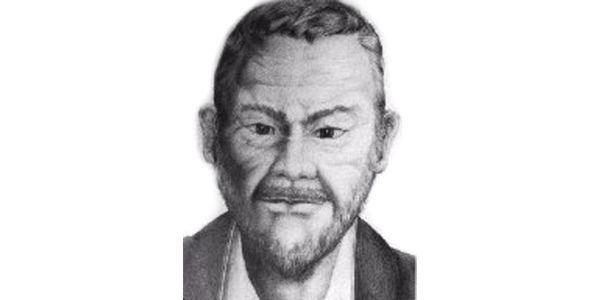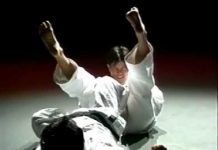The Two-Story Shoulders of Kanna
Part Two
Azato’s Political Force
The Lesson in Azato Village
By Gichen Funakoshi
Translated & Edited by Patrick & Yuriko McCarthy
Editor’s Note: This article is the second of two excerpts from a new book, “Karatedo Tanpenshu,” a collection and new English translation of early writings of Funakoshi, historical photos and other materials compiled and translated by Patrick and Yuriko McCarthy. The orignal Funakoshi articles were written in 1934 for the Keio Gijuku Taiiku-kia Karate Bu Kaiho.
The Two-Story Shoulders of Kanna
A close friend of mine, named Shoko, told me the story of Kanna Yoshin. The story of Yoshin is quite familiar among the educated in the Chinese or Japanese classics. Illustrating the importance of combining physical training with scholarly pursuit in order to master martial arts, “Bun Bu Ryo Do” is an old proverb understood by all martial artists and aptly described the kind of person Kanna Yoshin was.
His dedication to training and study was unprecedented, and he was build like a house. His arms, shoulders and neck muscles were virtually the size of a two-story building. Hence, he acquired the nickname “two story-shoulders Kanna.”
Like Azato, so too did Kanna love swordsmanship. However, in spite of his physical prowess he could never defeat Azato Sensei, though having tried on several occasions. Kanna was extremely disappointed with himself, as he could never seem to get the better of Azato, in spite of stepping up his training. Actually, it was never Kanna’s physical skill which prevented him from overcoming Azato, but rather his mind set and my teacher’s unique ability to read an attack and destroy it in progress.
I remember Sensei speaking to me about such issues and importance he placed upon strategy if one was to overcome any adversary. “From a martial arts point-of-view, one must study three separate issues to develop a kind of clairvoyance about judging a person’s character,” Sensei told me.
The first is “Man” (Japanese pronunciation) meaning to fulfill. The second is “Soon,” meaning a short measure of distance. The third is “Etsu,” meaning to surmount, or go beyond, like in the first example of “Man,” Kanna was a typical over-achiever and his over-confident character reflected such. “Therefore,” Sensei said, “If one is able to correctly evaluate the condition of one’s opponent, then it merely becomes an issue of addressing his weakness.” In the case of Kanna’s ongoing attempts to defeat Azato, that is just exactly what he did. Azato simply used “Soon” and “Etsu” to overcome Kanna’s “Man.”
“Actually,” Sensei told me, “it doesn’t matter if it is swordsmanship or karate, the principles of combative engagement remain the same, regardless. For example, if I purposely make an opening in an attempt to deceive my opponent, the chances are that he will try to attack it. Expecting such a thing, I can exploit his movement and overcome his weakness.”
The Political Force of Azato
As I mentioned previously, my teacher was a typical scholar warrior of Ryuku Kingdom and did much to contribute to the culture of Okinawa. In addition to his martial arts prowess he was one of two well-known political figures during his time. His counterpart was a man named Mr. Ishado Seiei. Judging by his close relationship with various celebrities and Japan’s top politicians, including the Prime Minister himself, Azato was intelligent and as skillful, and he was influential.
After Japan made the transition from feudalism into democracy, and Okinawa officially became part of the Japanese empire, much of the confusion and unrest over cultural assimilation was left in the hands of men like Azato and Ishado.
With political strengths radically shifting in Okinawa after the Sino-Japanese war of 1894/95, Azato’s upward mobility strengthed both the foundation and directions of his campaign. It was just about then that his Excellency, the Sho Marquis sought out the advice and political assistance of men like Azato and Ishado in seeking to strengthen the economy and morale of Okinawan society.
Supporting the Marquis, the collective efforts of Azato and Ishado laid a political foundation upon which the Kodokai (the precursor of Okinawa’s present day parliamentary government) was established.
During the Meiji Restoration, a time of great political change in Japan, the Kodokai reformation supported mainland policy implicitly and sought to facilitate its movement in Okinawa. Among the many social changes was abolishing the Chongmage (topknots) hairstyles. In spite of some opposition, it was largely because of the widespread support of the Kodokai that reformation was successful.
During that time Okinawa’s royal family had been relocated to Tokyo’s Kojimachi, near Yotsuya. However, it was because of his administrative prowess that master Azato remained at the forefront of political power in Okinawa until his retirement. Azato was really considered a local hero by many.
The Lesson in Azato Village
An old saying maintains that people of lower rank like to copy the actions of the upper ranks. During Azato’s time there were a group of brave young men in his village with little or no moral constitution. They often took pleasure in showing off, and sometimes even picked on weak or helpless passers-by at night. As such, Azato’s village developed a terrible reputation for unprovoked violence.
Learning of this situation, Azato Sensei decided to remedy the problem and developed a plan. Changing his cloths to look like a commoner, he strolled through the village late one night. Sure enough, not long after he entered the village district, a person jumped out from the cover of night and attacked him without warning or provocation. With no intention to mortally injure the man, Sensei dropped him with a single blow to the head.
The following morning Sensei petitioned the village chieftain to quickly assemble everyone in the center of the village. Curiously, everyone gathered to see what all the commotion was about. Everyone showed up except one young man. Sensei asked why the young man was not present, and he was told that he was sick. Assuming that the sick man was the culprit Sensei sent his private palanquin (symbol of status and a conveyance: a covered wooden couch mounted on poles which can be carried on the shoulders of two or four men) to fetch him. Soon the young man with a fresh bandage on his face arrived in the palanquin.
In front of all the villagers, Sensei asked him what was wrong? Unable to lift up his head from pain, the man murmured, “I was drunk last night and fell in the ditch.” Outraged, Sensei screamed at the fellow, “Don’t lie to me boy, now tell me the truth or else.” Finally, the young man confessed to the assault on Azato and begged for forgiveness.
Sensei publicly told the villagers that, in an effort to rid the district of their terrible reputation,, he had been out trolling for the gang and been attacked by the man in question. “It was me,” said Sensei to the man. “I was the one who knocked you senseless last night.”
After Azato’s lesson in the village that day the district became safe again to travel at night and ultimately regained its reputation as a safe and quiet neighborhood.
In spite of the countless anecdotes surrounding Azato Sensei, I believe that I have written enough for now. One thing, however, I would like to say is that Master Azato had planned to write a training manual on martial arts when he retired from public service. Unfortunately, he passed away before starting the project. It is this writer’s humble opinion the martial arts world suffers greatly not having the work of Azato Ankoh.
Sensei used to say that, “The purpose of martial arts is not just to build a strong and healthy body, but also to educate one’s mind and forge the spirit. Martial arts seeks to build the body, improve one’s character and find inner-harmony. It cannot guarantee it.”
Among his favorite books were Sun Tsu’s “Art of War,” and “The Six Strategies of War,” Lao Tsu’s “Tao Te Ching,” San Lue,” Wei Ryao Zi,” Su Ma Fa,” and Tang Ling Wen Dui.” Master Azato believed that the “Art of War” was the Bible for all martial artists. Whenever I recall the fact that Sensei had not published his knowledge, philosophy and application for future generations, I cannot but feel empty.










